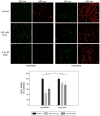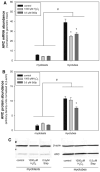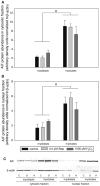Cell death-resistance of differentiated myotubes is associated with enhanced anti-apoptotic mechanisms compared to myoblasts
- PMID: 21161388
- PMCID: PMC3045653
- DOI: 10.1007/s10495-010-0566-9
Cell death-resistance of differentiated myotubes is associated with enhanced anti-apoptotic mechanisms compared to myoblasts
Abstract
Skeletal muscle atrophy is associated with elevated apoptosis while muscle differentiation results in apoptosis resistance, indicating that the role of apoptosis in skeletal muscle is multifaceted. The objective of this study was to investigate mechanisms underlying apoptosis susceptibility in proliferating myoblasts compared to differentiated myotubes and we hypothesized that cell death-resistance in differentiated myotubes is mediated by enhanced anti-apoptotic pathways. C(2)C(12) myoblasts and myotubes were treated with H(2)O(2) or staurosporine (Stsp) to induce cell death. H(2)O(2) and Stsp induced DNA fragmentation in more than 50% of myoblasts, but in myotubes less than 10% of nuclei showed apoptotic changes. Mitochondrial membrane potential dissipation was detected with H(2)O(2) and Stsp in myoblasts, while this response was greatly diminished in myotubes. Caspase-3 activity was 10-fold higher in myotubes compared to myoblasts, and Stsp caused a significant caspase-3 induction in both. However, exposure to H(2)O(2) did not lead to caspase-3 activation in myoblasts, and only to a modest induction in myotubes. A similar response was observed for caspase-2, -8 and -9. Abundance of caspase-inhibitors (apoptosis repressor with caspase recruitment domain (ARC), and heat shock protein (HSP) 70 and -25 was significantly higher in myotubes compared to myoblasts, and in addition ARC was suppressed in response to Stsp in myotubes. Moreover, increased expression of HSPs in myoblasts attenuated cell death in response to H(2)O(2) and Stsp. Protein abundance of the pro-apoptotic protein endonuclease G (EndoG) and apoptosis-inducing factor (AIF) was higher in myotubes compared to myoblasts. These results show that resistance to apoptosis in myotubes is increased despite high levels of pro-apoptotic signaling mechanisms, and we suggest that this protective effect is mediated by enhanced anti-caspase mechanisms.
Conflict of interest statement
Figures










Similar articles
-
Enhanced survival of skeletal muscle myoblasts in response to overexpression of cold shock protein RBM3.Am J Physiol Cell Physiol. 2011 Aug;301(2):C392-402. doi: 10.1152/ajpcell.00098.2011. Epub 2011 May 18. Am J Physiol Cell Physiol. 2011. PMID: 21593448 Free PMC article.
-
Apoptotic signaling induced by H2O2-mediated oxidative stress in differentiated C2C12 myotubes.Life Sci. 2009 Mar 27;84(13-14):468-81. doi: 10.1016/j.lfs.2009.01.014. Epub 2009 Feb 3. Life Sci. 2009. PMID: 19302811 Free PMC article.
-
Induction of mitochondrial biogenesis protects against caspase-dependent and caspase-independent apoptosis in L6 myoblasts.Biochim Biophys Acta. 2013 Dec;1833(12):3426-3435. doi: 10.1016/j.bbamcr.2013.04.014. Epub 2013 May 2. Biochim Biophys Acta. 2013. PMID: 23643731
-
The pro-inflammatory oxidant hypochlorous acid induces Bax-dependent mitochondrial permeabilisation and cell death through AIF-/EndoG-dependent pathways.Cell Signal. 2007 Apr;19(4):705-14. doi: 10.1016/j.cellsig.2006.08.019. Epub 2006 Nov 14. Cell Signal. 2007. PMID: 17107772
-
Dietary resveratrol confers apoptotic resistance to oxidative stress in myoblasts.J Nutr Biochem. 2017 Dec;50:103-115. doi: 10.1016/j.jnutbio.2017.08.008. Epub 2017 Aug 24. J Nutr Biochem. 2017. PMID: 29053994 Free PMC article.
Cited by
-
Villous trophoblast apoptosis is elevated and restricted to cytotrophoblasts in pregnancies complicated by preeclampsia, IUGR, or preeclampsia with IUGR.Placenta. 2012 May;33(5):352-9. doi: 10.1016/j.placenta.2012.01.017. Epub 2012 Feb 16. Placenta. 2012. PMID: 22341340 Free PMC article.
-
Enhanced survival of skeletal muscle myoblasts in response to overexpression of cold shock protein RBM3.Am J Physiol Cell Physiol. 2011 Aug;301(2):C392-402. doi: 10.1152/ajpcell.00098.2011. Epub 2011 May 18. Am J Physiol Cell Physiol. 2011. PMID: 21593448 Free PMC article.
-
Global Proteome Changes in the Rat Diaphragm Induced by Endurance Exercise Training.PLoS One. 2017 Jan 30;12(1):e0171007. doi: 10.1371/journal.pone.0171007. eCollection 2017. PLoS One. 2017. PMID: 28135290 Free PMC article.
-
Mature neurons dynamically restrict apoptosis via redundant premitochondrial brakes.FEBS J. 2016 Dec;283(24):4569-4582. doi: 10.1111/febs.13944. Epub 2016 Nov 18. FEBS J. 2016. PMID: 27797453 Free PMC article.
-
Essential amino acid supplementation alters the p53 transcriptional response and cytokine gene expression following total knee arthroplasty.J Appl Physiol (1985). 2020 Oct 1;129(4):980-991. doi: 10.1152/japplphysiol.00022.2020. Epub 2020 Sep 3. J Appl Physiol (1985). 2020. PMID: 32881622 Free PMC article.
References
-
- Jagani Z, Khosravi-Far R. Cancer stem cells and impaired apoptosis. Adv Exp Med Biol. 2008;615:331–344. - PubMed
-
- Melet A, Song K, Bucur O, Jagani Z, Grassian AR, Khosravi-Far R. Apoptotic pathways in tumor progression and therapy. Adv Exp Med Biol. 2008;615:47–79. - PubMed
-
- Friedlander RM. Apoptosis and caspases in neurodegenerative diseases. N Engl J Med. 2003;348:1365–1375. - PubMed
-
- Kermer P, Liman J, Weishaupt JH, Bahr M. Neuronal apoptosis in neurodegenerative diseases: from basic research to clinical application. Neurodegener Dis. 2004;1:9–19. - PubMed
-
- Adams V, Jiang H, Yu J, et al. Apoptosis in skeletal myocytes of patients with chronic heart failure is associated with exercise intolerance. J Am Coll Cardiol. 1999;33:959–965. - PubMed
Publication types
MeSH terms
Substances
Grants and funding
LinkOut - more resources
Full Text Sources
Research Materials

